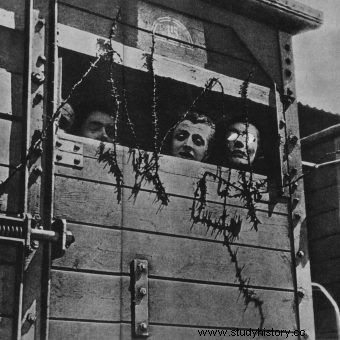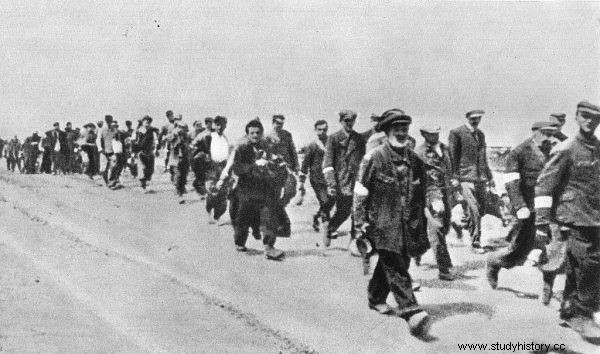There was no way to hide the shocking-scale deportation of European Jews. However, it was possible to mask its real purpose - especially from those who got into the carriages going east. Thanks to the cruel system of lies and illusions, most of the victims entered the gas chamber by themselves…
"Nobody imagined that one day such an extermination camp like Auschwitz could be created" - says in the book "The Nazi's Wife" Edith Hahn-Beer, a Jewish woman who survived the war as a "diver", hiding her true origin. The woman admits that as the fighting continued, she heard rumors of Nazi atrocities and the terrible conditions in the concentration camps. "Oh, that's an exaggeration, it must be hostile propaganda" She told herself, however. The discovery of the scale of the German crimes was a shock to her.

Jews, deported from all over Europe, were not sure until the very end what awaited them.
Millions of inhabitants of Europe, occupied by the Third Reich, thought like her. And no wonder. Although anti-Semitic slogans were omnipresent, and Hitler and Goebbels in their speeches revealed their intentions towards Jews, the Nazi authorities made sure that the actual shape of the "final solution" was kept secret. Already at the beginning of January 1942, the Reich Press Office ordered that no information be published on the "Jewish question in the occupied eastern territories". The order was carried out - there was silence in the official media.
Success of propaganda
Moreover, for the needs of international public opinion (and partly also of the Holocaust victims themselves), a number of "masking" procedures were launched. Their goal was to convince everyone that despite all restrictions, Jews could lead a relatively safe life in the territory of the Reich. According to Dorit Bader-Whiteman, researcher of the fate of Jewish refugees:
Even after the mass murder began, the Nazi efforts to deceive the world continued. Famous Jewish artists were forced to perform on a specially built stage in Westerbork , a German assembly point in the Netherlands, against Jews being sent to their deaths.

Propaganda portrayed concentration camps as centers where prisoners work hard but are treated fairly. The camp for elderly Jews in Theresienstadt was a model example.
Actress Camilla Spira said that she was dressed up as the wife of the innkeeper, with blonde braids, and sang operetta arias [...] for a thousand Jewish prisoners who they came to Auschwitz at night . "It was terrible," she recalls. “For a while they forgot everything. The next day, the trains took them to their deaths. ”
The Nazis also put a lot of effort into convincing the world of the innocent nature of the concentration camps they were building. From the moment they took power, they presented them as the stark contrast to the British centers of the Boer Wars. Propaganda painted a picture of institutions where prisoners who perform work "for the common good" are treated severely but fairly. Some of them were also placed there allegedly so that they would not take their jobs from full-fledged citizens.
The appearance of civilized conditions was maintained even during the war. The "model" camp was Theresienstadt, established in the Czech city of Terezin. There were sent there - already during the implementation of the "final solution" - including Jews over 65 and World War I veterans, and later also more famous personalities. And it was there that the representatives of the Red Cross were invited to investigate the conditions of detention of the prisoners.
After the scenery was properly "prepared", the guests who came in June 1944 were shown the idyllic place. They could walk along the charming streets, among flowers and freshly painted building facades, visit the functioning library and the place of prayers. Theresienstadt was also not crowded - before the visit, 7,500,000 people were sent to Auschwitz to free some space. The envoys of the Red Cross were deceived by this idyll - organization she canceled further visits to camps, including Auschwitz itself !
"My mother is a maid? Impossible! ”
Thanks to these and other measures, the deported Jews, especially those from Western Europe, had only a vague idea of what awaited them after their departure to the East. This is confirmed by Edith Hahn-Beer in a memoir book published under the title "The Nazi's Wife. How a certain Jewish woman survived the Holocaust ” :
Polish Jews have already been sent back to Poland. Now, in the summer of 1941, we heard that German and Austrian Jews would also have to go there. These deportations - or Aktionen , as we called them, filled us with fear. We did not know then what the deportation to Poland meant, but we sensed that it was no good.
We thought of this country as an uncivilized wilderness where the Germans colonize and subjugate the local peasants. If they sent Mom to Poland - I thought - she would have to be a servant for the German colonists:washing dishes, scrubbing floors, ironing clothes . I couldn't bear the thought of being in such conditions. My mother a maid? Impossible!
To many victims, such a scenario would seem plausible. In 1941, the authorities of the Third Reich published a brochure which presented the life of Jews in the occupied Poland as at least bearable. Although their work was awaiting them, also - as the authors of the text praised - clean hospitals, kitchens, their own press, and even a vocational training system!

Those shipped east were promised a new life - difficult but bearable conditions.
When organizing subsequent transports to the east, the Nazis also took great care of the language. There was rarely any mention of "deportations". Terms such as "evacuation" or "resettlement" and even simply "moving outside the Reich" were used more often. In order to make this fairy tale credible, the "carried out" people were often charged with the costs of their travels. There were also high standards, even 50 kg, for allowed luggage.
"It won't get any worse ..."
The situation was somewhat different among the Jews locked up in ghettos in occupied Poland, who could no longer have any illusions about the nature of the regime. Even for them, however, the true purpose of the deportation often remained unknown. "We didn't know where we were going and what awaited us" - said Samuel Willenberg, who was sent to Treblinka from the ghetto in Opatów. He also adds that although he heard Poles ironically saying that the Jewish population was sent "to gas" and "turned into soap", but he simply did not believe it.

After arriving at the "transit" camp in Sobibór, the prisoners were forced to "shower".
Successive transports were mostly accepted with horror, but there were few exceptions. “Many German Jews decided to travel voluntarily. They were completely demoralized, could not stand life in Łódź for a moment longer, and they hoped that their unknown goal could mean an improvement in the situation, "says Holocaust researcher David Cesarani.
Even when terrifying rumors began to circulate among the deportees in Łódź, this group took their fate indifferently. "More than five months of hunger and cold on bare floors does not in the least make them fight for life in the ghetto" - recorded in the chronicle of the Lodz ghetto - "They say that wherever they go, it will not be worse for them" .
All the way
The illusion of a journey "eastward" created by the Germans, where Jews would be able to settle down, was sustained until the last moment. As historian Laurence Rees recounts:
SS experience has shown that deception is the key to the smooth running of the death camp. Treblinka pretended to be a transit camp and the new arrivals were sent to their deaths as soon as possible, driving them "to the showers" in the "disinfection block".
Similar appearances of normality were created in Sobibór. Oberscharführer Hermann Michel greeted the prisoners with a short speech in which he explained that they would be directed to Ukraine, where they had to work hard. "You have to undress and leave your things in order," he then reported, "we don't have much time." After leaving the showers, he argued, they should be able to get up quickly on their way.
"People believed him," says Cesarani. They undressed, donated their valuables and money. Some people buried them in the sand, hoping they would get them back when they got back from the shower. They didn't know there would be no return.
